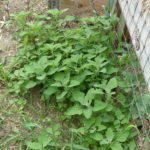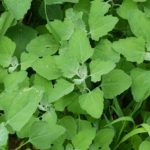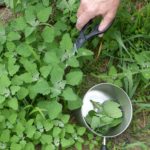Every summer we enjoy dining on Swiss chard and spinach, but one of our favorite greens to come from the garden is lamb’s quarters. It’s a plant with many common names that is ready to pick and eat before chard or spinach mature. Some call the plant pigweed but that name is also used for other species. Lamb’s quarters remain edible through the summer as long as only tender young leaves are plucked.
Lamb’s quarters is a “no work” green. We never plant, cultivate, or water it. It’s not necessary. It’s a weed that plants itself and pops up in the garden and on the edge of the lawn. We only have to pick, wash, cook, and eat it.
What IS Lamb’s Quarters?
This amazing garden and yard weed grows almost everywhere in the United States and probably lives near just about every person. A usually disliked garden chore is pulling or hoeing weeds. Often those weeds are just discarded or composted. It’s ironic that often those weeds are tastier and more nutritious than the crop being weeded. Lamb’s quarters is one of the best and easiest of the edible weeds.
Lamb’s quarters is an erect branched plant with leaves that shed water. Sprinkle a few drops on the plant and they’ll either bead up or run off, leaving the leaf dry. Try it!
How Do You Process Lamb’s Quarters?
We pick a small pot full of young lamb’s quarter leaves and stems, rinse them well, and steam or boil them for about ten minutes. They are delicious when topped with a dab of butter or a bit of oil and vinegar. Lamb’s quarters cook down significantly, so a pot full of raw leaves will yield only a small amount of cooked vegetables. Pick plenty. If the plant is allowed to mature the tiny seeds are also edible and nutritious but processing them is beyond tedious. Lamb’s quarter leaves can also sparingly be used raw in salads.
- Lamb’s Quarters readily grow in disturbed soil.
- The silvery leaf sheds water.
- A full pot of raw Lamb’s Quarters cooks down to a few fork fulls of this nutritious potherb.
Caveat!
Before eating a new wild plant make sure you have correctly identified it from at least two reputable sources, such as wild edible books, the Internet, or a skilled foraging mentor. Then only eat a small amount the first time. Occasionally a plant may be delicious and harmless to most people but allergic to a few.
Use Identification Sources
Our favorite sources for wild edible information are the classic Stalking the Wild Asparagus book by Euell Gibbons and A Field Guide to Edible Wild Plants by Lee Peterson. Many websites also feature this plant. A helpful website is Edible Wild Food.




